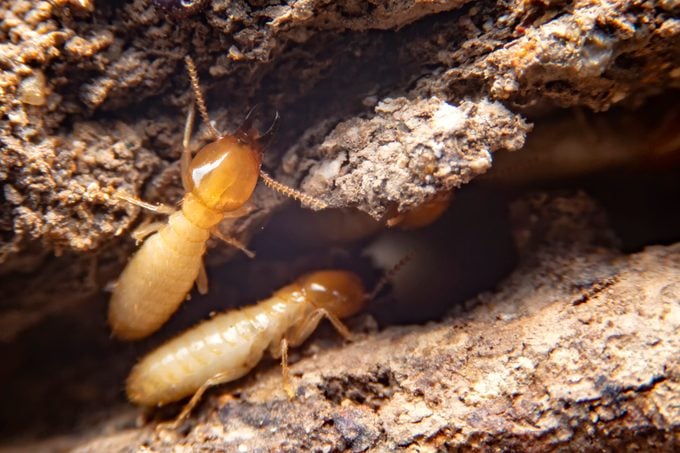Termites are extraordinarily talented at destruction. Each year, they cause more than $5 billion in property damage in the U.S., and most homeowner’s insurance plans don’t cover termite damage. Plus, damage from termites is more common than damage from flood or fire.
And termites are not just a problem in warm climates. Although infestations are more common in Southern states, termites live in every state except Alaska, as far as pest-control experts can tell. (They’re also found in parts of Canada.)
You can prevent a termite crisis with regular inspections. Experts recommend one every one to three years while watching for signs of termites yourself. Professional exterminators shared a few other things they want you to know:
Moisture Leaks Are a Big Deal
“Excess moisture will attract termites and other household pests,” says Ralph Fisher at Earthwise Termite & Pest. If you have a leak in your home, remove or thoroughly dry all the saturated wood. Repair any dripping hose bibs or sprinkler issues, too.
“Termites need shelter, food (wood) and moisture to live,” says Eric Hoffer of Hoffer Pest Solutions. “Any moisture leak, such as in the roof or in the fascia, will allow termites to survive.” Also check tricky spots such as your air conditioning drip lines. They can pool up against the house, and termites will use that as a moisture source.
Termites Eat 24 Hours a Day, Seven Days a Week
Nancy DeWitt, owner of Patriot Pest and Termite Control says, “Termites never sleep, which means they are continuously consuming wood and damaging your property.” Left untreated, it could seriously weaken the foundation and structure of your home.
But that’s not all. Termites don’t only eat wood. They’ll consume anything with cellulose, an indigestible fiber commonly found in plants. “So, aside from chewing on woods, they can feast into your garden plants, too,” DeWitt says.
Other materials containing cellulose include wallpaper, paper, books, clothing, furniture, cardboard boxes, etc. So instead of storing things in cardboard boxes, DeWitt recommends plastic bins for storage.
Maintain an Inspection Gap
For any home with a stucco exterior, make sure the stucco doesn’t reach the ground. “Instead, you want to have a one- to three-inch gap, also known as an inspection gap, which will allow you to see termites coming from the soil up,” Hoffer says.
Likewise, watch out for wood-to-ground contact such as a fence post. “This type of area is ripe for termites,” he says.
Termites Flock to Home Additions
Fisher advises caution when expanding your home. “Add-ons are a great way to increase the square footage of your home, but termites should be considered before the process begins,” he says.
Case in point: Pouring new concrete against the existing concrete creates a seam. Termites can fit through cracks as small as 1/32-in., and Fisher says a new seam may provide termites access to the home while remaining undetected. Fisher suggests homeowners consult an extermination professional about treating the soil and/or studs.
Also, Fisher says to take caution when installing a new deck.
“When placing a deck against the home, you are creating a physical barrier,” he says. “Make sure to run the boards parallel to the home. This will come in handy should a termite professional need to use a liquid chemical treatment application. Removing two boards parallel with the home is much easier than removing the whole deck.”
And, Fisher says, make sure you leave enough room for a visual inspection of the foundation.

Think About Other Sources of Wood and Food
Hoffer also recommends removing old stumps from your yard. “A stump provides a great feeding ground for termites to feast,” he says.
“And if you’re an avid gardener, beware that mulch can come with termites,” Fisher says. “In some cases, homeowners are actually paying to have termites delivered to the home via mulch. Ask your landscape specialist if you have any mulch options to minimize the amount of termites brought in with bulk mulch. Bagged mulch can also have termite activity as well, yet it’s far less likely.”
Get an Annual Inspection
Every year, have a professional come out and do an inspection, Hoffer says. Preventive treatment works, and it’s a lot cheaper than dealing with an infestation after the fact.
“They will see things that you don’t see,” he says. “Typically, most professionals will do it at no charge. They may try to sell you on a service while they’re out there, but you don’t have to purchase that.”
Termite Control Is an Ongoing Solution
“Most homeowners probably have heard that termites live in colonies and there are many termites in a single colony,” Hoffer says. “That being said, I don’t think they understand just how big and destructive these colonies can be. The average termite colony can contain anywhere from 75,000 to 250,000 individual termites.”
Because these colonies can be so large, most termite services are not one-and-done. Hoffer says exterminators should use a tailored approach depending on the customer’s specific termite infestation.
“If they have a full-blown termite infestation, then we’ll first focus on eradicating the current infestation,” Hoffer says. “This is a tall task due to the large number of individual termites in a colony, so we’ll then implement a termite monitoring system to ensure that all the termites have been eradicated.”
Thinking about cutting corners and hoping for the best? Don’t. “If a termite service is offering you a one-time service, it runs the risk of not killing all the termites in a colony, allowing them to rebuild their colony and putting your home back in danger,” Hoffer says.
Article source here: 7 Things Your Termite Exterminator Wants You To Know


No comments:
Post a Comment